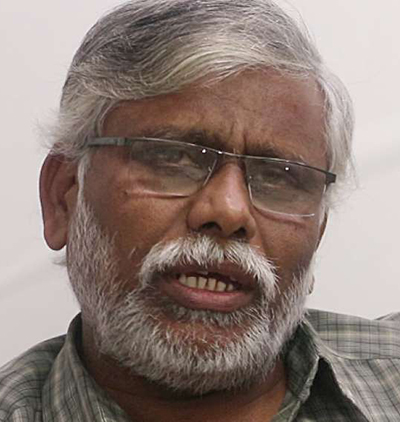- Among the pre poll surveys two surveys looked most trust worthy- CSDS – Loknithi and Rajdeep Sardesai’s channel. According to CSDS the likely seat Congress would get jumped from 90 in April to 100+ in May. This increase was predicted while Modi was busy with his rallies. (Those who are in the know, know why CSDS is credible).
- Though Rajdeep Sardesai is not pro BJP he had predicted that BJP would win in both 2014 LS elections and UP assembly elections in 2017. Presently he predicts that Congress would get 106-118 seats in Karnataka. Moreover his exit poll base is much bigger (around 70000)
- Though C-Four seems pro Congress, its exit poll base too is significantly large (27000). Even if we deduct around 5% vote share it predicts, even then the outcome seem to favour Congress.
- The polling percentage is highest in 2018 in the post independent era. For this kind of record voting either there should be a visible wave or women must have voted in large numbers as they did in 2013.
- If Modi wave were to be factor, then the voting in cities should have been significantly higher. As the data in other districts do not provide city based voting percentage, let us take Bangalore as an indicator. The polling in Bangalore is 10% less than what it was in 2013. It suggests that those who were influenced by Modi did not feel like voting!!
- If that is true then, higher polling must be due to the voting by women, backward communities and minorities. In 1978 when similar polling occurred (71.8 ) Congress led by Devaraj Urs had registered a massive victory.
The present scenario is akin to that. According to India today, over 48% Dalits and 80% Muslims have supported Congress. In 2013, where Muslim voters were over 40% BJP had won 6 out of 15. This time Modi & co must have contributed for a greater polarization of Muslim votes.
Generally 70% of the voters vote for their traditional favourite party. Hence we should look for the trends in voting pattern. We have only CSDS data regarding this (of April-May) that trend seems to favour Congress.
If someone wants to debate this logically, a discussion is worth it! I am subject to correction. But merely stating that Today’s Chanakya or C-Four predicts so does not prove anything.
If results prove this wrong, then
- The polling did not happen according to this logic
- EVMS should be doubted.
- The methodology and inference of the surveys must be faulty.
My analysis does not mean that I am pro Congress. This is an attempt to understand an electoral exit poll survey scientifically. Anyway, we have our role cut out.. Whoever wins, we may have to function as a vigilant opposition!

DR. H.V. VASU

SHIVASUNDAR
Let the Truth be known. If you read VB and like VB, please be a VB Supporter and Help us deliver the Truth to one and all.
New Delhi (PTI): Russia agreed to encourage joint manufacturing in India of military hardware and spare parts for maintenance of Russian-origin arms and defence equipment.
Ways to bolster overall bilateral defence cooperation figured prominently during summit talks between Prime Minister Narendra Modi and Russian President Vladimir Putin on Friday.
It has been a long-standing grievance of armed forces that the supply of critical spares and equipment from Russia takes a long time, affecting the maintenance of military systems procured from that country.
"Both sides agreed to encourage joint manufacturing in India of spare parts, components, aggregates and other products for maintenance of Russian origin arms and defence equipment under Make-in-India programme through transfer of technology," a joint statement said.
ALSO READ: India, Russia explore cooperation on small modular reactors, floating nuclear power plants
It said both sides also agreed to set up joint ventures for meeting the needs of the Indian armed forces as well as subsequent export to mutually friendly third countries.
The joint statement said the India-Russia defence partnership is being reoriented to take up joint co-development and co-production of advanced defence technology and systems.
In their meeting on Thursday, Defence Minister Rajnath Singh and his Russian counterpart Andrey Belousov resolved to expand bilateral defence cooperation.
In the meeting, the Indian side showed keen interest in procurement of additional batches of S-400 missile systems from Moscow to bolster its combat prowess.
In October 2018, India signed a USD 5 billion deal with Russia to buy five units of the S-400 air defence missile systems, notwithstanding a warning by the US that going ahead with the contract may invite US sanctions under the provisions of Countering America's Adversaries Through Sanctions Act (CAATSA).
Three squadrons have already been delivered.
The S-400 systems played a crucial role during Operation Sindoor. India may also look at procuring the S-500 missile systems from Russia.
In the Modi-Putin talks, the two sides also agreed to continue jointly developing systems of bilateral trade settlements through the use of national currencies.
Additionally, the two sides agreed to continue their consultations on enabling the interoperability of the national payment systems, financial messaging systems, as well as central bank digital currency platforms.
Modi and Putin appreciated the ongoing intensification of the joint work on a free trade agreement on goods between India and the Eurasian Economic Union, covering sectors of mutual interest, the joint statement said.
They also directed both sides to intensify efforts in negotiations on a mutually beneficial agreement on the promotion and protection of investment, it said.
India and Russia also welcomed steps to ensure long-term supply of fertilisers to India and discussed the potential establishment of joint ventures in this area.





